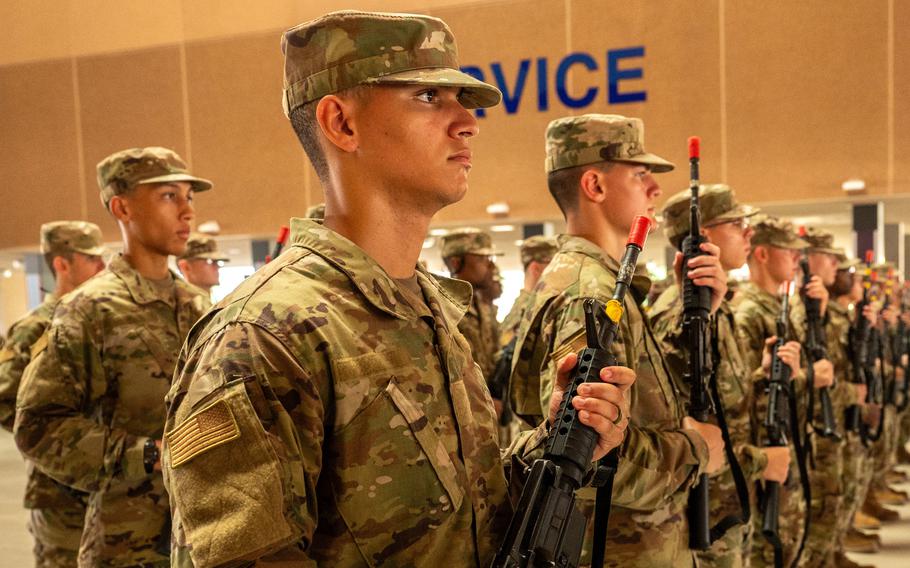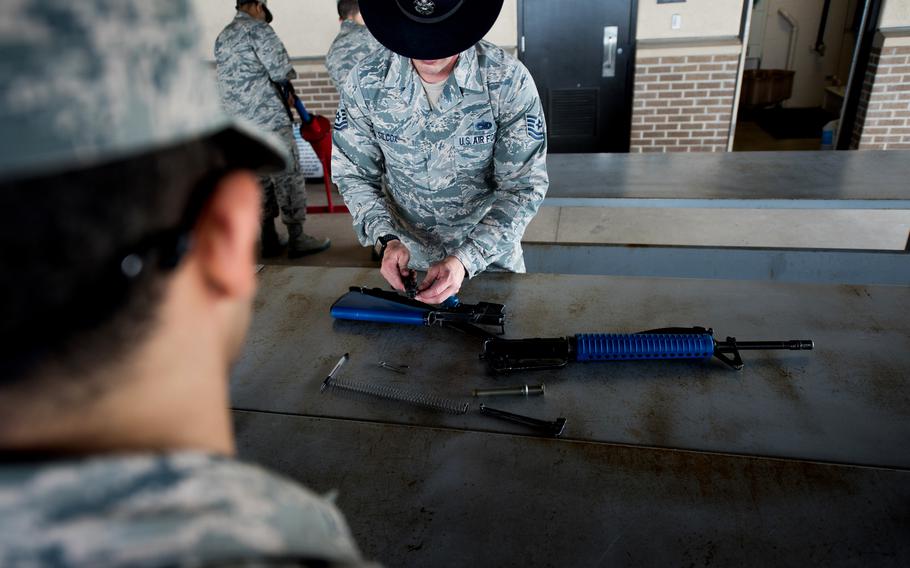
U.S. Air Force Basic Military Training trainees carry M4 rifles at Joint Base San Antonio-Lackland, Texas, on Aug. 2, 2024. The reintroduced weapons program emphasizes constant weapon handling throughout basic training. (Ava Leone/U.S. Air Force)
The Air Force’s newest airmen are spending a lot more time with weapons than their predecessors have for more than a decade.
Since the end of July, airmen and guardian trainees have been carrying inert M4 rifles — marked with distinctive red flash suppressors — as part of their daily regimen, a practice that stopped in 2012, according to officials with the 37th Training Wing, the unit which hosts the training at Joint Base San Antonio-Lackland.
Trainees receive the weapons following an initial familiarization course during the first week of training.
From the moment they are issued their M4 rifles, the weapons are by their sides nearly every step of the way through the remaining seven weeks of basic training. The few exceptions are during activities such as medical appointments or when wearing their blue service uniforms.
All the while, instructors apply their own brand of mentorship to guide the trainees to “develop a sense of ownership for their weapon,” officials said a statement announcing the change Monday.

M4 rifles are securely stored in lockers at Joint Base San Antonio-Lackland on Aug. 13, 2024. These inert weapons are part of the Air Forces reintroduced Trainer Weapon Program. (U.S. Air Force)
After carrying and caring for their weapons for weeks, trainees attend a full combat arms training day of four to five hours in the classroom and three hours on the range.
Here they learn how to safely react to malfunctions and fire the weapon while wearing a gas mask and chemical gear.
“Incorporating practice weapons into realistic scenarios in a controlled environment builds confidence, corrects errors, and manages stress by providing regular practice that reduces hesitation and increases combat effectiveness,” said Col. Billy Wilson Jr., the head of the 737th Training Group.
Trainer weapons, a common sight in Army and Marine Corps boot camps, have received varying levels of emphasis within the Air Force’s basic training over the years.
“Weapons familiarization was still very much a part of the curriculum, trainees just didn’t carry them at all times as training priorities are continually adjusted,” said Christa D’Andrea, a spokeswoman with the 37th Training Wing, in an email to Stars and Stripes.
Previously, Air Force trainees used a modified version of the M16A2 rifle during training. Unlike standard blue trainers made fully out of plastic, the rifles were essentially demilitarized versions with blue buttstock and hand guard.

Air Force Tech. Sgt. Pete Silcox, an instructor with the 331st Training Squadron, demonstrates how to assemble the M16 trainer weapon, May 2, 2019, at Joint Base San Antonio-Lackland. These trainer weapons were recognizably marked with blue buttstock and hand guards. (Sarayuth Pinthong/U.S. Air Force)
Inert training models offer distinct advantages. If one of these rifles is lost or stolen, the repercussions are less severe than with a real weapon, which can trigger base-wide lockdowns and comprehensive searches of all base vehicles. Additionally, they’re better suited for rigorous training activities such as striking drills against dummies, which could compromise the accuracy and safety of a live-fire weapon.
In 2019 the service made the switch to train incoming service members on the more current M4 model to align with equipment in the active Air Force arsenal.
The reintroduction of the trainer weapon is part of a long-running effort to better prepare airmen and guardians for future potential conflicts with powerful adversaries, officials said.
One of the first comprehensive modernization efforts was the introduction of PACER FORGE, which stands for Primary Agile Combat Employment Range, Forward Operations Readiness Generation Exercise.
Implemented in November 2022, this scenario-based deployment exercise, executed in the seventh week of training, replaced the Basic Expeditionary Airman Skills Training, better known as BEAST, and represented the first major change to the culminating exercise at basic training in 16 years.